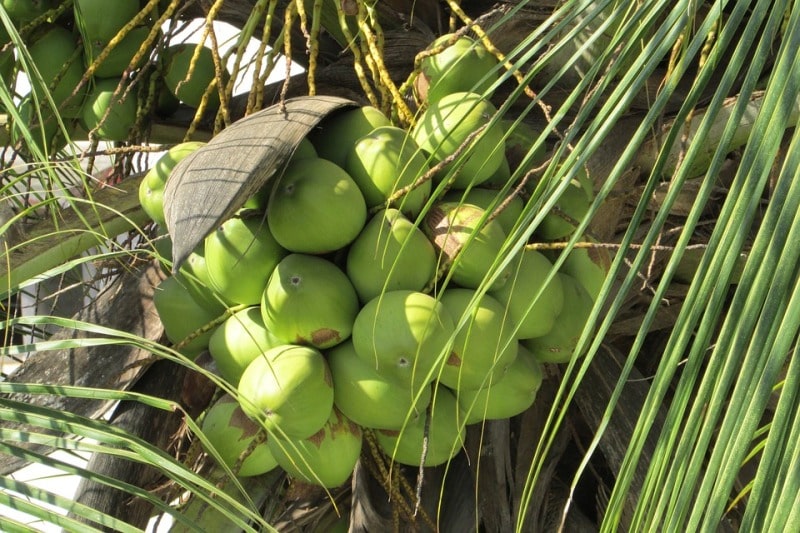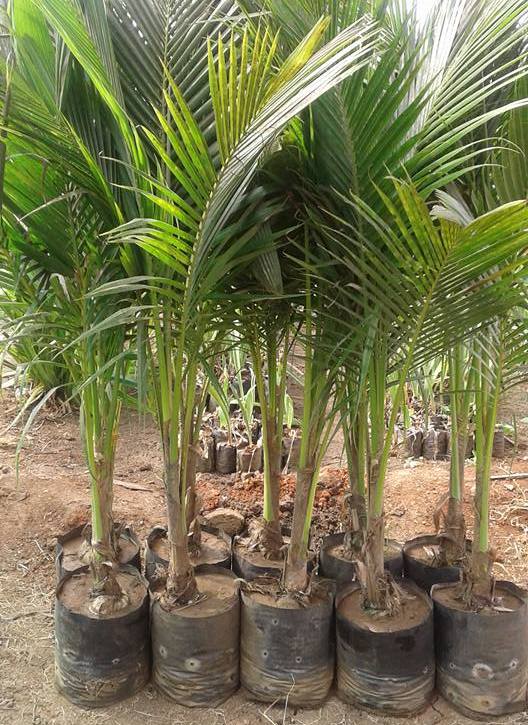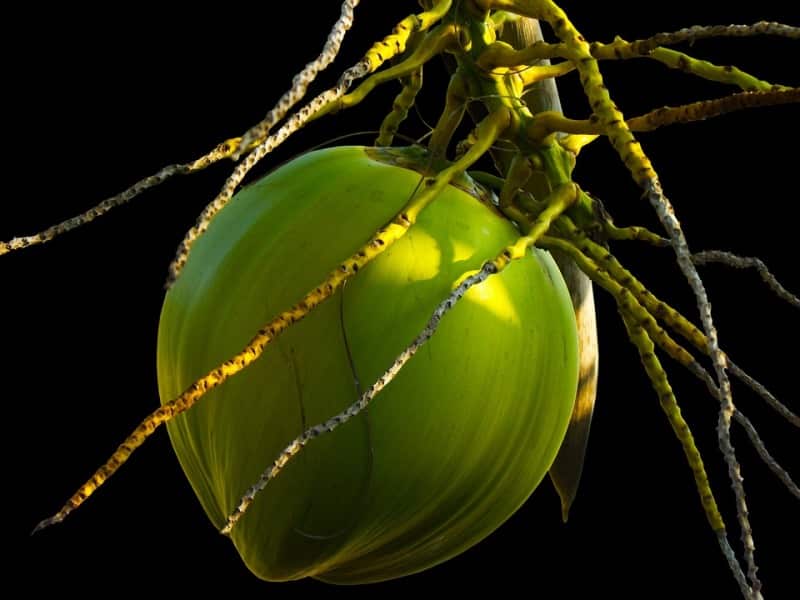A step by step guide for hybrid coconut cultivation, Planting
Today, we discuss the hybrid coconut cultivation yield, profitable hybrid coconut varieties and farming practices.
Coconut (Cocos Nucifera) plays an important role in the agrarian economy of India. Apart from the importance of copra and coconut oil which is normally used in the manufacture of soaps, hair oil, cosmetics, and other industrial products. Its husk is a source of fiber which will support a sizable coir industry. Coconut is a crop of small and marginal farmers since 98% of about 5 million coconut holdings in the country are less than two hectares.
Hybrid coconut palms:
Hybrid coconuts are inter-varietal crosses between two morphological forms of coconut trees. In particular, hybrids from Dwarf and Tall, Tall and Tall varieties also generate high-yielding coconut palms. Generally, hybrid coconut palms are more superior in terms of quality and quantity of copra production. They also have the greatest amount of copra per nut. As such, they are generally selected for commercial planting.

The hybrid crosses between Dwarf and Tall varieties have exhibited marked hybrid vigor by having the benefits found in both palms. Normally, high yielding hybrid coconut trees are resistant to environmental stress, including drought and diseases. They bear fruits after three to four years of planting. When compared to Dwarf and Tall varieties, hybrid coconut palms have more nut yields and higher copra production. The copra and oil produced are also of better quality.
Some of the advantages of planting hybrid coconuts are given below;
- Early fruiting (3 to 4 years versus 6–8 years for open-pollinated, native varieties)
- Semi-dwarf growth habit which facilitates very easy harvesting.
- The relatively high content of medium-chain fatty acids (6 to 12 carbon fatty acids) which are more healthful than those from competitive vegetable oils.
- High yields and good coconut production would provide an income of formers above the poverty level.
- The main advantage of hybrid coconut plants is that they start flowering from the second year, by the third year all the trees will come to flowering stage and from the fourth year, all the trees will start to provide the yield.
Characteristics of hybrid coconuts:
- Hybrids are formed in two ways, with tall as female parent and dwarf as male parent (Tall x Dwarf) or dwarf as the female parent and tall as male parent (Dwarf x Tall).
- When the tall is used as female they are known as TxD hybrid while the reciprocal is known as DxT hybrid. Hybrid coconuts perform well under good management conditions including nutrient management and irrigation.
- They show earliness in flowering and provide increased yield, higher quantity and better quality of copra and oil when compared to the parents.
- Besides intervarietal hybrids like Tall x Tall and Dwarf x Dwarf are also formed.
Cultivars and hybrids:
Coconut cultivars are classified into two groups they are tall and dwarf.
The tall coconut cultivars that are extensively grown are the West Coast Tall and East Coast Tall. The dwarf variety is very shorter in stature and its life span is short as compared to the tall. Tall x Dwarf (TxD), Dwarf x Tall (DxT) are the two important hybrid coconut varieties.
There are different combinations of hybrids, developed by Kerala Agriculture University and Tamil Nadu Agriculture University. They are very high yielders under good management conditions. Laccadive Ordinary, Andaman Ordinary, Philippines, Java, Cochin-China, Kappadam, etc are the other tall cultivars under cultivation.
You may also like Jasmine Cultivation Project Report.
List of coconut hybrid varieties:
Let us discuss some of the Hybrid coconut varieties;
Kerasankara (WCT x COD)
The palm comes to bearing by the 4th year of planting. The mean annual yield of nuts is 108 with a range of 70 to 130 nuts. The copra content is 187g/nut. This hybrid was released by Central Plantation Crops Research Institute (CPCRI) in 1991, for large scale cultivation in Kerala, coastal Andhra Pradesh and coastal Maharashtra.
Chandrasankara (COD x WCT)
The coconut palms come to bearing early when compared to tall palms. It is a heavy yielder and produces 116 nuts/palm with a range of 100 to 150 nuts. The copra content in the nut is 160 to 230 g. It is susceptible to drought and irrigation is required during summer months. Chandrasankara hybrid was released by CPCRI in 1985 for cultivation in Kerala and Karnataka.
Kalpa Sreshta (MYD x TPT)
The mean yield will be 167 nuts/palm/year, with estimated high copra out turn of 35.9 kg/palm/year or 6.28t/ha copra. The hybrid is appropriate for tender nut purpose. This hybrid coconut is recommended for cultivation in Kerala and Karnataka States.
Chandralaksha (LCT x COD)
The hybrid palm comes to bearing in about 4 to 5 years after planting. The annual yield is 109 nuts/ palm with a copra content of 150 to 210g/nut. The hybrid coconut was released by CPCRI.
Kalpa Samrudhi (MYDxWCT)
The mean annual yield will be 117 nuts per palm. The copra yield will be 4.38 t/ha and oil is 3.04 t/ha. The hybrid is appropriate for tender nut purpose. This hybrid was suggested for cultivation in Kerala and Assam.
Kalpa Sankara (CGDxWCT)
The mean annual yield is approximately 85 nuts per palm. The copra yield will be 2.5 t/ha and oil is 1.69 t/ha. This hybrid was recommended for cultivation in the root or wilt disease prevalent tracts of Kerala.
Keraganga (WCT (West Coast Tall) x GBGD (Gangabondam Green Dwarf))
This hybrid released by Kerala Agricultural University in 1988 for cultivation in Kerala. This hybrid recommended for general cultivation both under rainfed and irrigated conditions.
Lakshaganga (LCT x GBGD)
This hybrid coconut released by Kerala Agricultural University in 1987 for large scale cultivation in Kerala. This is one more drought-tolerant hybrid and grows well even under rainfed condition.
Anandaganga (ADOT x GBGD)
This hybrid coconut released by Kerala Agricultural University in 1999 for large scale cultivation in Kerala. This hybrid recommended for general cultivation both under rainfed and irrigated conditions.
Kerasree (WCT x MYD)
This hybrid released by Kerala Agricultural University in the year 1992 for cultivation in Kerala state.
Kerasoubhagya (WCT x SSAT)
This hybrid recommended by Kerala Agricultural University in 1993 for large scale cultivation in Kerala, Karnataka and Tamil Nadu.
VHC 1 (ECT x MGD)
This hybrid released by Tamil Nadu Agricultural University in 1982 under the name ‘Veppankulam Hybrid Combination – 1’ or VHC-1 for general cultivation in Tamil Nadu. These tend buckling which is to be prevented by providing support.
VHC 2 (ECT x MYD)
This hybrid released by Tamil Nadu Agricultural University in 1987 under the name ‘Veppankulam Hybrid Combination – 2’ or VHC-2 for general cultivation in Tamil Nadu.
VHC 3 (ECT x MOD)
This hybrid released by Tamil Nadu Agricultural University in the year 2000 under the name ‘Veppankulam Hybrid Combination – 3’ or VHC-3 for cultivation in Tamil Nadu.
Suitable hybrid coconut varieties for Tamil Nadu:
Kerasankara (WCT x COD), Chandrasankara (COD x WCT), Kerasoubhagya (WCT x SSAT), VHC 1(ECT x MGD), VHC 2(ECT x MYD), VHC 3(ECT x MOD)
Suitable hybrid coconut varieties for Kerala:
Kerasankara(WCT x COD), Chandrasankara (COD x WCT), Chandralaksha(LCT x COD), Keraganga (WCT x GBGD), Lakshaganga (LCT x GBGD), Anandaganga(ADOT x GBGD), Kerasree (WCT x MYD), Kerasoubhagya (WCT x SSAT)
Suitable hybrid coconut varieties for Karnataka:
Kerasankara (WCT x COD), Chandrasankara (COD x WCT), Chandralaksha (LCT x COD), Kerasoubhagya (WCT x SSAT)
Soil requirement of hybrid coconut cultivation:
The Hybrid coconut palm can tolerate a wide range of soil conditions. However, the palm does show certain growth preferences. Some of the factors influencing the growth of the coconut palm are drainage, soil depth, soil fertility and layout of the land have a great influence on the growth of the palm. The main soil types that support coconut cultivation in India are laterite, alluvial, red sandy loam, and coastal sandy and reclaimed soils with a pH ranging from 5.2 to 8.0.
Selection of site for coconut cultivation:
Soil with a minimum depth of 1.2m and fairly good water holding capacity is chosen for coconut cultivation. Shallow soils with underlying hard rock, low lying areas subjected to water stagnation and clayey soils must be avoided. Proper supply of moisture either through well-distributed rainfall or irrigation and sufficient drainage are essential for Hybrid coconut.
You may be interested in Cherry Tomato Farming in India.
Planting material
Normally, coconut is propagated through seedlings raised from selected seed nuts. Generally, 9 to 12-month-old seedlings are mainly used for planting. Select seedlings, which have 6 to 8 leaves and 10-12 cm collar girth when they are a 9-12-month-old. Early splitting of leaves is another criterion in the selection of Hybrid coconut seedling.

Time of planting:
Coconut seedlings can be transplanted at the beginning of the southwest monsoon. If irrigation facilities are available, it is desirable to take up planting at least a month before the onset of the monsoon so that the seedlings get well established before heavy rains. Planting can be taken up before the onset of the north-east monsoon.
Planting the seedlings during May month, with the onset of pre-monsoon rains is ideal. Under assured irrigation, planting could be done during April also. In low- lying areas, plant the seedlings in September month after the cessation of heavy rains.
Coconut planting:
Before planting the pits are filled up with topsoil and powdered cow dung or compost up to a depth of 50 to 60 cm. Then take a small pit inside this, therefore as to accommodate the nut attached to the seedling. Plant the coconut seedling inside this pit and fill up with soil. Press the soil well thus as to avoid water stagnation. If there is a possibility for white-ant attack apply Sevidol 8G (5gm.) inside the small pit before planting.
In laterite, areas apply 2 kg common salt per pit for developing the physical condition of the soil. Burying 25 to 30 coconut husks per pit in layers will be more useful for moisture conservation.
You may also check the Soyabean Cultivation Project Report.
Manures and fertilizers used for coconut cultivation:
Regular manuring right from the first year of planting is necessary for good vegetative growth, early flowering, and bearing and sustainable yield of coconut palms. The first application of chemical fertilizers must be done after three months of planting.
Rock phosphate is recommended as a source of phosphorus in lateritic soils and acidic soils. Fertilizers can be applied in two split doses during May-June and September-October for the rain-fed palms and in four or more equal splits for irrigated palms avoiding the heavy rainfall period. In sandy soils with acidic nature, in addition to these fertilizers, 1 kg of dolomite can be broadcast during April-May in the basins and incorporated into the soil by forking.
Irrigation
Hybrid coconut responds well to summer irrigation. Under summer irrigation, 40 liters per palm per week will increase the yield of nuts by 50%. Under basin irrigation, 200 liters per palm once in 4 days will be beneficial. In areas where water is scarce drip irrigation system could be adopted. The quantity of water recommended for drip irrigation in hybrid coconut is 66 percent of the open pan evaporation.
Hybrid coconut harvesting:
Hybrid coconuts are harvested at varying intervals in a year. The frequency will differ in different areas depending upon the yield of the trees. In well maintained and high yielding gardens, bunches are formed regularly and harvesting is done once a month.

Coconuts become mature in about twelve months after the opening of the spathe. It is the ripe coconut which is the source of main coconut products. Nuts which are eleven months old give fiber of good quality and can be harvested in the tracts where green husks are necessary for the manufacture of coir fiber.
The life span of any coconut tree, not only hybrid, is 60 to 80 years and as hybrid plants give higher returns farmers can reap benefits till 25 to 30 years. Later than that, it is best to replace the product which shall mean loss of one year’s income. Further, it is a fact that as the hybrid coconut trees grow old their productivity will decrease gradually.
The number of coconuts for hybrid coconut tree shall give 250 coconuts per tree per year leading to an annual production of 1 to 17,000 coconuts per acre.
That’s all folks about the cultivation of hybrid coconut and planting methods. Keep growing coconuts!.
You may be interested in Growing Lavender, Planting, Care, Harvesting.
What distance you observe between 2 coconut treee when planting.
Thanks!
Usually, 10 to 15 feet.
Good One !!
How many plants we can plant in an acre of Ganga Bhavani breed
What is the yielding of Ganga Bhavani coconut plants in an year (hybrid plant)
is Ganga Bhavani , the hybrid plant? what are their parental varieties?
Yearly which tree is giving the high yield quantity.
Which one is best for Low irrigation
How many cocunuts will come for per tree in a year ??
The Dwarf or Tall which is best for commercial purposes?
i am confuse for identify my coconut plant (which veriety?)
please help me and reply.
can i send some pics of my coconut plant for identify? (on Whatsapp)
Please give me contact number.. To buy original saplings, want to buy some original dwarf verity plants.. Please help
Good day. I am in Jamaica. Thank you so much for this information. I found the article very interesting and informative.
How would I get access to these varieties for planting in the Caribbean and what additional guidance could I get as it relates to soil preparation, testing etc.
Which variety is good for water production versus oil versus peat. We mainly use coconuts for the water but I would love to explore the possibilities of developing other aspects /industries
Please recommend a coconut plant for Khandala area which is in Maharashtra.
Send me ur details from Wre I can purchase it I want around 200 hybrid plants
There is very less information in the internet about “Kappadam” variety of coconut trees and the coconuts. Please help me understand whether it grows tall , or short like a hybrid. How does the shell look like? What is special about Kapadam variety, etc..